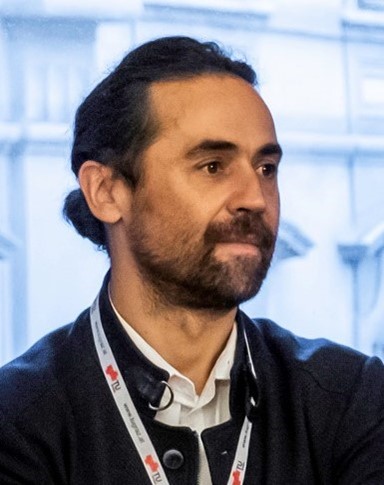ABSTRACT
The media of the aorta consists primarily of smooth muscle cells (SMCs) embedded in a highly structured matrix of collagen fibrils and elastin lamellae. Thanks to their phenotypic plasticity [1], SMCs normally maintain a certain mechanical homeostasis through variations of their active tone (contractile phenotype, short-term adaptation) and through synthesis and remodeling of the extracellular matrix (ECM) (synthetic phenotype, long-term adaptation). However, missensing of mechanical stimuli by SMCs (stress, strain, or stiffness) can alter the maintenance of mechanical homeostasis and induce impaired adaptations that are responsible for thoracic aortic aneurysm (TAA) [2]. Accordingly, there is a pressing need to investigate and model how SMC biomechanics participate in the development of TAAs.
Our recent contributions on this topic were both computational and experimental:
• using a finite-element model of growth and remodelling based on the constrained mixture theory, we showed that cell mechanosensitivity plays a critical role in TAA progression and remodelling [3].
• using traction force microscopy (TFM) on primary SMCs (Fig. 1), we recently found that SMCs of aneurysmal aortas apply larger traction forces than SMCs of healthy aortas [4]. We explained this result by the increased abundance of hypertrophic SMCs in aneurysmal aortas. Our experimental results also confirmed that SMCs modulate their traction forces according to the stiffness two regimes. We even found that SMCs apply optimal traction forces for a substrate stiffness of 12 kPa [5].
It is now unanimously acknowledged that before catastrophic events such as rupture or dissections, TAAs enter a vicious circle combining phenotypic modulation/loss of SMCs and compromised biomechanical properties of the wall. Improvements in clinical care and prognosis will require that we are able to couple cell models informed by our recent experimental results with tissue level models of arterial mechanobiology [6]. About mechanoregulation, the motor–clutch-based model [7] may be the way to put forward, as it can also relate stiffness increase of the aortic wall to the increase of aortic failure.
References
1. Lacolley et al, Cardiovasc. Res. 95(2), 194-204, 2012.2.
2. Humphrey et al, Circ. Res. 116(8), 1448-1461, 2015.3.
3. Mousavi et al, Comp. M. Prg. Biomed. 205, 106107, 2021.4.
4. Petit et al, Biomech. Model. Mechanobiol. 20(2), 717-731, 2021.5.
5. Petit et al, Mol. Cell. Biomech., 2019.6.
6. Irons and Humphrey, PLoS comp. biol. 16(8), e1008161, 2020.7.
7. Chan and Odde, Sci. 322(5908), 1687-1691, 2008.
SPEAKER CV
 Stéphane Avril is Professor at Mines Saint-Etienne (France) where he heads the research unit on vascular dysfunctions. His research group has made significant contributions in finite element modelling of cardiovascular applications, now transferred to a start-up named Predisurge. In 2015, Stéphane was awarded an ERC Consolidator Grant to investigate the mechanobiology of aortic aneurisms. Recently awarded an ERC Proof of Concept and after several visiting professorships at Yale University (USA), TU Vienna (Austria) and TU Graz (Austria), Stéphane has been investigating more and more the role of smooth muscle cells in aortic mechanobiology.
Stéphane Avril is Professor at Mines Saint-Etienne (France) where he heads the research unit on vascular dysfunctions. His research group has made significant contributions in finite element modelling of cardiovascular applications, now transferred to a start-up named Predisurge. In 2015, Stéphane was awarded an ERC Consolidator Grant to investigate the mechanobiology of aortic aneurisms. Recently awarded an ERC Proof of Concept and after several visiting professorships at Yale University (USA), TU Vienna (Austria) and TU Graz (Austria), Stéphane has been investigating more and more the role of smooth muscle cells in aortic mechanobiology.
He is an author of 200+ publications in peer-reviewed journals and 4 patents.






